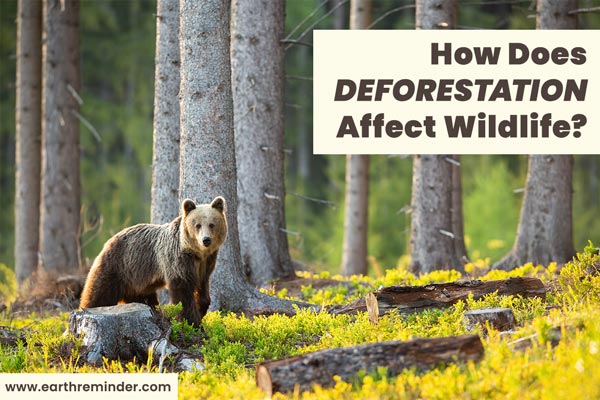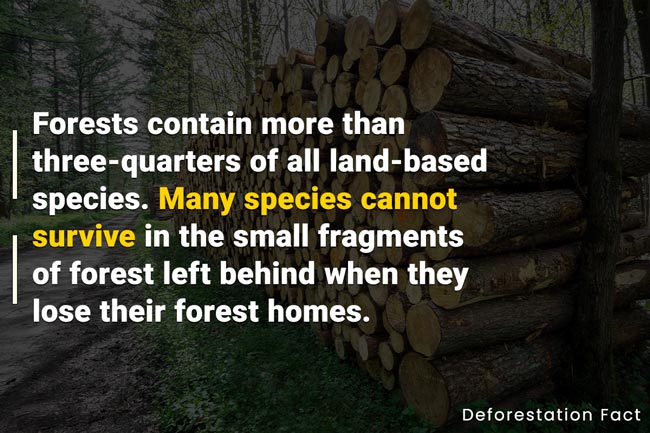How Does Deforestation Affect Wildlife?
How Deforestation Affects Wildlife?
Rapid clearing of trees signifies a huge loss of tree cover and forests. It’s the forests where most of the wildlife live; therefore, shrinking forests due to deforestation has serious effects on wildlife.
The WWF Living planet report of 2020 points out a catastrophic decline in wildlife. According to the report, in the last 50 years, the wildlife population that includes mammals, birds, amphibians, reptiles has declined by two-thirds. One of the main culprits of this rapid decline in wildlife population across the globe is deforestation.
It has become evident that deforestation leads to species extinction. Besides, deforestation devoid wildlife of their home, food sources, and hunting areas and exposes them to increased predation risk. These factors lead to the rapid decline of wildlife in the given region and an irreversible loss of biodiversity.
Want to learn the serious damage deforestation does to wildlife in detail? Then bear with us and discover how deforestation affects wildlife.
Table of Contents
Effect Of Deforestation on Wildlife
Forests provide a home to almost 80% of animal species worldwide. Furthermore, forests also provide the space to hunt, find food, reproduce and grow. Basically, forests fulfill all the needs of species that dwell there. Therefore, when forests deplete, species living there lose their natural dwellings. This disturbs their whole life cycle. Also, they are exposed to new environments, not suitable for their biological needs. As a result, wildlife in the deforested area shrinks rapidly to a point where some species go extinct, never to walk the Earth again.
Here is how deforestation impact wildlife;
Deforestation leads to Habitat Loss
Deforestation in an area kicks the wildlife out of that place. No tree covers force animals to find new places to live. While a few species may survive their new surroundings, most of them cannot. Habitat loss drastically impacts the animal population in that area and leads to a severe loss of wildlife.
Therefore, the loss of habitat is the most damaging impact of deforestation on wildlife. According to the IUCN’s red list, habitat loss due to deforestation is the biggest threat to more than 80% of wildlife globally.
For example, habitat loss has nearly pushed Tigers and Lions to extinction in India.
Loss of Food Source for Wildlife
Animals dwelling in the forest depend on them for food. Loss of forests leads to the shrinking of food sources essential for the survival of wildlife. For example, Panda and mountain Lemurs face a serious threat of extinction due to shrinking bamboo jungles – a primary food source for these animals.
The International Network for Bamboo and Rattan (INBAR) and the UN Environment Programme’s World Conservation Monitoring Centre (UNEP-WCMC) report confirm this and warn that if the situation remains unresolved, we will soon lose a bigger chunk of the Panda and Lemur population.
Similarly, predatory animals also face the threat of extinction. Failing green covers leads to a severe food shortage for herbivores and their population decline. In the process, predatory animals who feed on those herbivores are also devoid of their food source, seriously affecting their population too.
Increased Interaction with Humans
Deforestation leads to encroachment of the human population on forest land and animal habitats. This leads to the confrontation of wildlife with humans. It can prove devastating for the wildlife in those areas.
It increases the risks of animals being hunted by humans in self-defense and safety. For example, monkeys and other wild animals often enter human dwellings for food. Also, closer boundaries with wildlife could lead to increased poaching activities.
Deforestation and clearing of lands also mean more vehicle activities in the wildlife habitat. These could seriously disrupt the serenity of the environment in which wildlife thrive. Besides, there is also the risk of animals being run over by vehicles.
Deforestation leads to Habitat Fragmentation
Habitat fragmentation differs from habitat loss. It leads to the development of patches of tree-covered land, which once was a continuous area.
Habitat fragmentation may lead to too small spaces that prevent wildlife species from thriving. Besides, it also leads to reduced shelter, food, and hunting space.
Moreover, a fragmented forest can only support a smaller population of animals. Smaller numbers are more prone to extinction. There is a limited number of species members to mate, which leads to a severe reduction in the gene pool. This leads to unhealthy offspring not suited to survive the harsh conditions.
For example, the Great Ape population of central Africa has been severely affected by habitat fragmentation, which is a direct result of deforestation.
Deforestation Is Making the Wildlife Sick
Numerous studies have pointed out that human impact on the habitat of wild animals is increasing the risk of disease spread amongst animals. Recently, ISPRA (Higher Institute for Environmental Protection and Research) has also raised concern about the increasing risk of illness in animals linked to decreasing forest cover.
Healthy forests with thick tree cover limit the spread of pathogens and therefore play a crucial role in regulating diseases. When the ecosystem is under stress due to deforestation, its ability of disease control and regulation is compromised, resulting in sick wildlife.
Besides, research done in South American Atlantic Forest also points out that deforestation leads to hormonal imbalance in wildlife. The study found out that animals living in deforested areas have a high level of certain hormones in their bodies. This imbalance weakens the immune system and exposes them to diseases.
Impact of Deforestation on Wildlife Conservation
A high rate of deforestation negatively impacts wildlife conservation efforts—deforestation results in land degradation, climate changes, and loss of ecosystems globally. One of the major concerns is the consequences of deforestation on species conservation.
Deforestation Destroy Biodiversity
The significant loss of tree cover is a major threat to biodiversity. Deforestation leads to contamination of the ecosystem, which in turn affects the conditions required by the wildlife to survive. Besides, habitat fragmentation is also a direct manifestation of deforestation.
Fragmentation affects the dynamics of the ecosystem and its functioning. It leads to genetic isolation destroying biodiversity. Fragmentation is detrimental to any conservation efforts because it limits the reproduction possibility of species and lack of gene pool prevents healthy offspring essential for survival.
Many Species of Animals Can Only Survive in Old Growth Forests
It’s a grave issue that hampers wildlife conservation efforts. Many wildlife animal species can only survive in the old-growth or virgin forest.
Old-growth forests have unique ecology essential for the survival of some species. Therefore, even if they are introduced to a new forest environment, their chances of survival remain bleak.
Animals like Marten and birds like marbled murrelet, and northern spotted owl etc., heavily depend on old-growth forests for survival. If these forests are subjected to deforestation, it puts these species in danger of extinction, and no amount of conservation efforts are enough to save them.
Deforestation Can Introduce Non-native Invasive Species
The introduction of invasive species could further stall conservation efforts. Native species have to compete for food and shelter with the invasive species, which can prove detrimental to native wildlife.
In such a scenario, it becomes challenging to get rid of the invasive species, which are often more adept at adapting to the new conditions. It negatively impacts the local wildlife and also affects wildlife conservation.
Conclusion
Effects of deforestation on wildlife lead to food shortage, habitat fragmentation, habitat loss, and loss of biodiversity. Many species that were in abundance in the past are now at the brink of extinction, only because of deforestation. Rapid loss of tree cover has even affected the ability of wildlife to adapt to the environment and weaken their immune system. The negative impacts of deforestation on wildlife are evident, and if we don’t take concrete steps to prevent deforestation, we will lose most of the wildlife soon.

